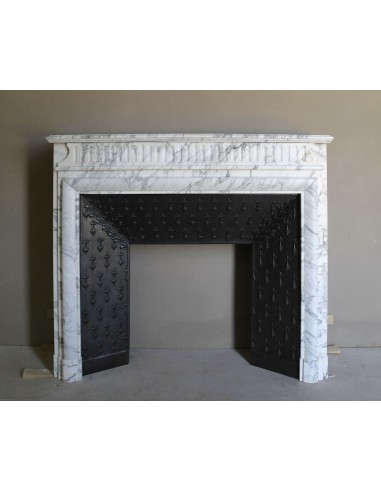It will be a long commentary, this one of our Boudin Haut (the term“haut” basically means“with precappa”), let alone that we have to start from the year 1650 or so, and then come to a first stop towards the end of the 17th century and, finally to the moment when “our” was born, which is datable to the mid-19th century...
In the mid-seventeenth century, a great Neapolitan artist (painter, writer, actor etc..) named Salvator Rosa invented the outline (or, if you prefer, the shape) of the mantel surrounding the mouth of our fireplace.. To mantelpieces, He, he had never thought about them, this specific mantel our hero had designed it to frame his paintings, until then forced to dress in Baroque decorations of an unbearable heaviness.... But a few decades later, toward the end of the seventeenth century, Parisian architects appropriated this invention to make it an elegant and highly original mantel for the approximately 1250 fireplaces of the Palace of Versailles.. Below, scrolling through fantastic images of the interiors of the Palace of Versailles(http://www.handelforever.com/VersaillesSuprema/versailles/palazzo/PrimoPiano/salonemarte.htm) you will see a fireplace “Boudin with precappa” in the Hall of Mars. Of course, the one in Versailles is not as beautiful as ours that we are presenting here, after all it was a kind of prototype and over time this model became very refined..
Let us start from here because the Boudin fireplace that I am presenting here is a 19th-century ( 1840-60) mantel whose inspiration comes from the model that appears in the center of this huge hall at the time dedicated to a concert hall (and just on either side of the fireplace itself were placed two stages for musicians) and dance...
The person who carved in Calacatta Classico marble the fireplace I am presenting to you is the mythical Boudin, a sympathetic “fanatic” of French Grandeur, of Napoleon in particular, but also (and he couldn't help but be) of the equally mythical Sun King, Louis XIV, the one who in Versailles created the most beautiful maison in the world.
Well, this gentleman was rather “autarkic” and it was not easy to get him to carve a fireplace in non-native marbles, however, this time he had to yield (and I am sure that never was a more pleasing rendering) to the warm chromaticism of our very Italian marble , a noble Calacatta Classico that had so fascinated the Etruscans and then again the Romans..
I feel I can say that our Boudin (you may think I am crazy but...it is now half a century that I have been stroking this gentleman's fireplaces and sometimes I feel I know for sure what he was thinking when he was working.... In short...I empathize, with a confidence that surprises myself first...) I would say, I was saying, that Boudin decided to use this marble because of its “soft” whiteness and its equally remarkable polishability... In short, “our” Calacatta was considered even then a marble endowed with great nobility.
Boudin's fireplaces may or may not be liked, but they are always of great constructive quality, no sparing was made in the sculpting workshops of this builder (in its heyday there were two such sculpting places, one in Nice and one in Marseilles, it was to those ports that the marbles came from Lunigiana), the thicknesses were important and the materials had to be first-rate, and, since Calacatta Classico marble was one of the top of the class, well, two and two make four..
Also very interesting is his cast iron insert with“a tapisserie” decoration ( definition meaning “with a single decoration that is repeated endlessly) with which our Boudin is endowed, too bad I can't confess to you what that sort of flower ”carpeting" its entire surface represents IF I REVEALED IT HERE, 90% OF THE POSSIBLE BUYERS WOULD GIVE UP THE PURCHASE.... THE SECRET WILL BE REVEALED TO THE BUYING CUSTOMER ONLY AFTER COLLECTING A FAIR DEPOSIT.
THE BIRTH OF THIS FANTASTIC “BOUDIN HAUT” TOOK PLACE IN THE CÔTE D'AZUR, FRANCE, AROUND THE MIDDLE OF THE NINETEENTH CENTURY, ITS DISCOVERY WAS IN PARIS, EXCELLENT PRESERVATION.










































































